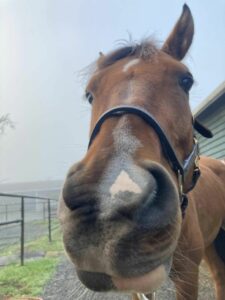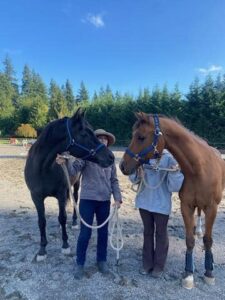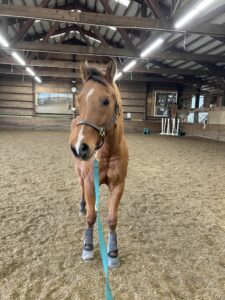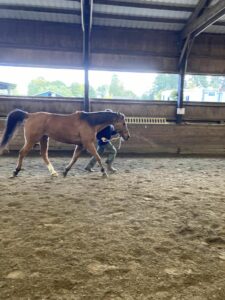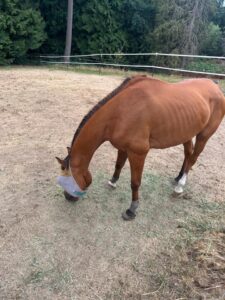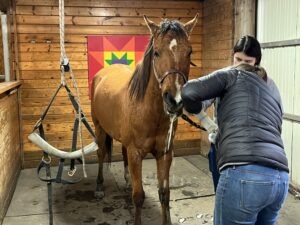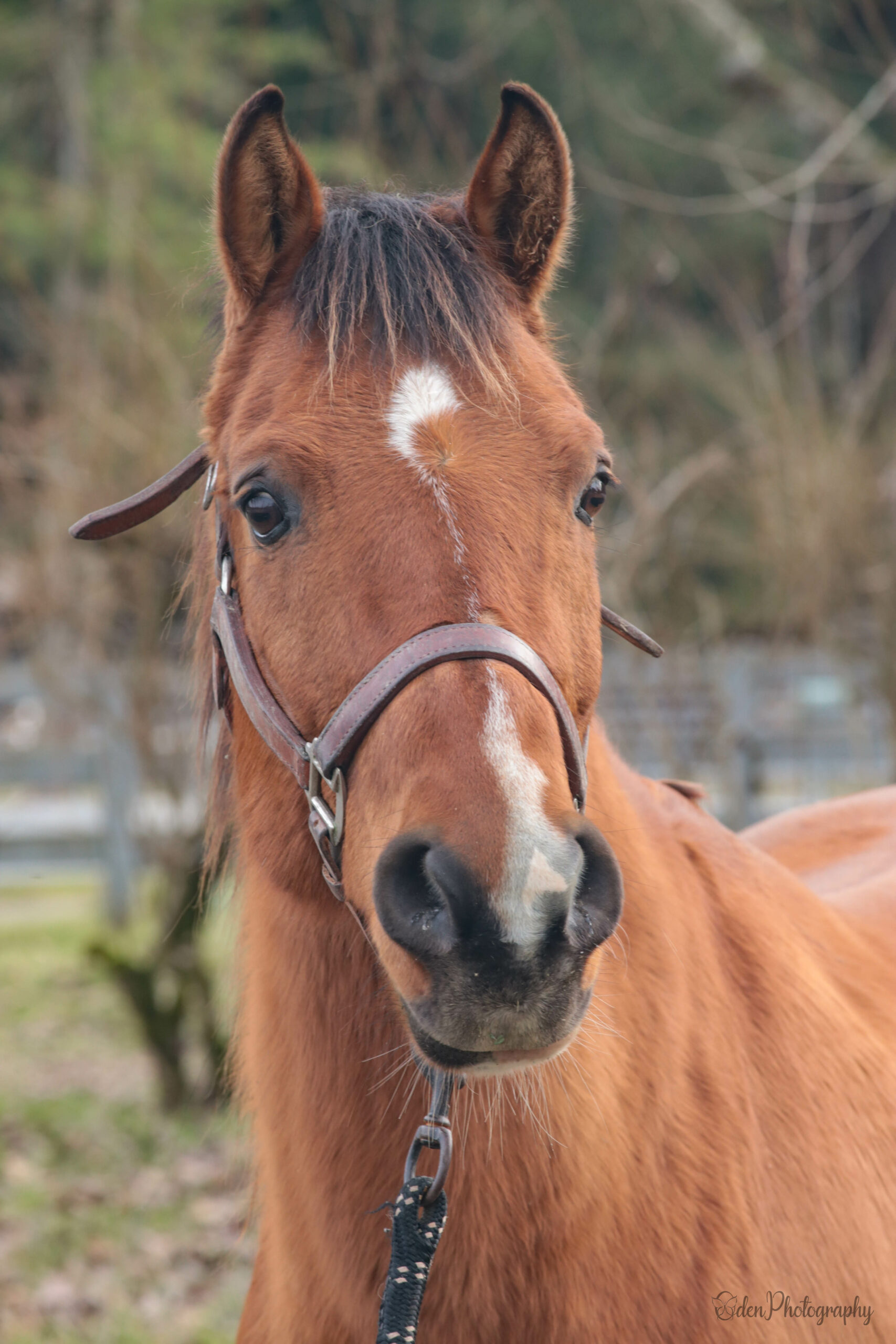Henry
2012 chestnut Arabian gelding
Type of Rescue: Animal Control Seizure
Intake Date: 11/28/2022
Adoption Date: 7/27/2023
Length of Time with SAFE: 8 months
ADOPTED!! by Marion!
Henry came to SAFE in November of 2022 as part of a seizure of 27 horses from Pierce County (who we called The Graham 27)
Henry arrived at SAFE as the most nervous of the bunch, quick to snort at the unknown and shy to be caught. But once on the end of a lead, we could tell what a sweet and gentle guy he was underneath his anxieties. With time, patience, and groundwork, Henry settled in and found a great deal of relaxation. He also found Marion, who was looking for a companion horse. The two of them got along famously, and in July, Henry moved to his new home. These days, Henry is living his best life, getting absolutely doted on by Marion — any horse’s dream!
Alumni Update: Henry (James)
Alumni Update: Henry (James)
October 2023
Update on James’ weight gain progress at almost 3 months after adoption! The first photo shows him when he initially arrived, while the second photo showcases his current appearance. Notably, he has been successfully building muscle in his shoulders and has significantly reduced his rib visibility.

Henry is Adopted!
When Henry first stepped off the trailer last November, he was a nervous gelding with his head on a high swivel. While the majority of the Graham horses we took in that day allowed us to bustle around them quite casually, gathering measurements and even some basic vitals, Henry remained wary of his new surroundings, of us. He was a delicate and sensitive guy, and would require a little longer than some to settle.
Every day, we told Henry that he could stay as long as he needed. And every day his head began to come down in increments, his anxiety reducing. We put him into work, where Bonnie helped him learn how to relax. Over the many hours they spent together, Henry learned how to stop panic-running along the edge of the round pen when sent loose, how to understand that the touch of a flag was not a scary thing, how to load onto a trailer calmly, and how to tune-in to his handler in a way that wasn’t simply out of fear, amongst many other things. He was a soft and responsive horse, and one who all that worked with him would describe as ‘a pleasure to have in class.’ Bonnie’s hard work alongside Henry helped set the stage for the day when he would meet the person who would take him home forever.
That day came in the summer, when a young, horse-loving lady contacted SAFE looking for a horse of her own. She was not looking for a riding horse, but rather a companion for herself, to dote on and shower with love and attention. When she met Henry, she fell in love. And Henry, who had come a long way from that gelding we first met, who was nervous to be haltered and handled, helped to show her what all he’d learned.
After several visits that helped to strengthen and solidify the bonds between horse and human, Henry was ready to make the trek to his new home. The morning of his departure, Henry only hesitated for a moment before hopping on the trailer, his second ever ride. Upon arriving, his human was there to greet and support him in his new environment, showing him around with the same love and care that Henry would receive every day for the rest of his life. After about an hour, Henry relaxed into his new home, and even came into a stall that night, something relatively new to him, without issue.
Over the last month they have been together, Henry, who is now called James, and his girl have spent loads of time together, and it was music to our ears when she told us at the end of their trial period that she wanted to keep Henry forever! It is a common belief that every young girl’s dream is to have a horse to call her own, and I think the only thing better than being a girl with a horse is being the horse of a girl.

Henry at the June Joel Conner Clinic
At our recent Joel Conner clinic, volunteer Sue C worked with Henry in the groundwork session. Here’s what she had to say about their time together:
“I had the fine fortune of having Henry as my groundwork partner for the June 2023 Joel Conner Clinic. He is a lovely 11 year old Arab gelding, who came to SAFE in November 2022. He is a bit anxious and fearful of the unknown lurking around each corner, but also quick to settle down and decide that he is ok. He is sensitive and soft and really wants to connect with his handler, so while he can be easily distracted by a mare strolling by, he is just as easily brought back to focus.
Henry has been given a great start by Bonnie. He improved and excelled at everything he was asked to do. He is a bit fearful of the flag, but like everything else he accepts it and settles down to work. He started out with his head in the air through each transition, but over the course of 3 days he really seemed to relax. His walk and trot are quite lovely when he relaxes. Henry taught me that every move I make matters, and by Sunday I was able to move him from unified circle, to hind quarters to front quarters on a long rope, with just my feet. That was a great feeling. We also worked on moving his front quarters 360 degrees, backing when needed. This was better on one side than the other, but more my affliction than Henry’s I think. He gives all his attention and tries so hard.
Henry will be a great partner for a lucky adopter!”
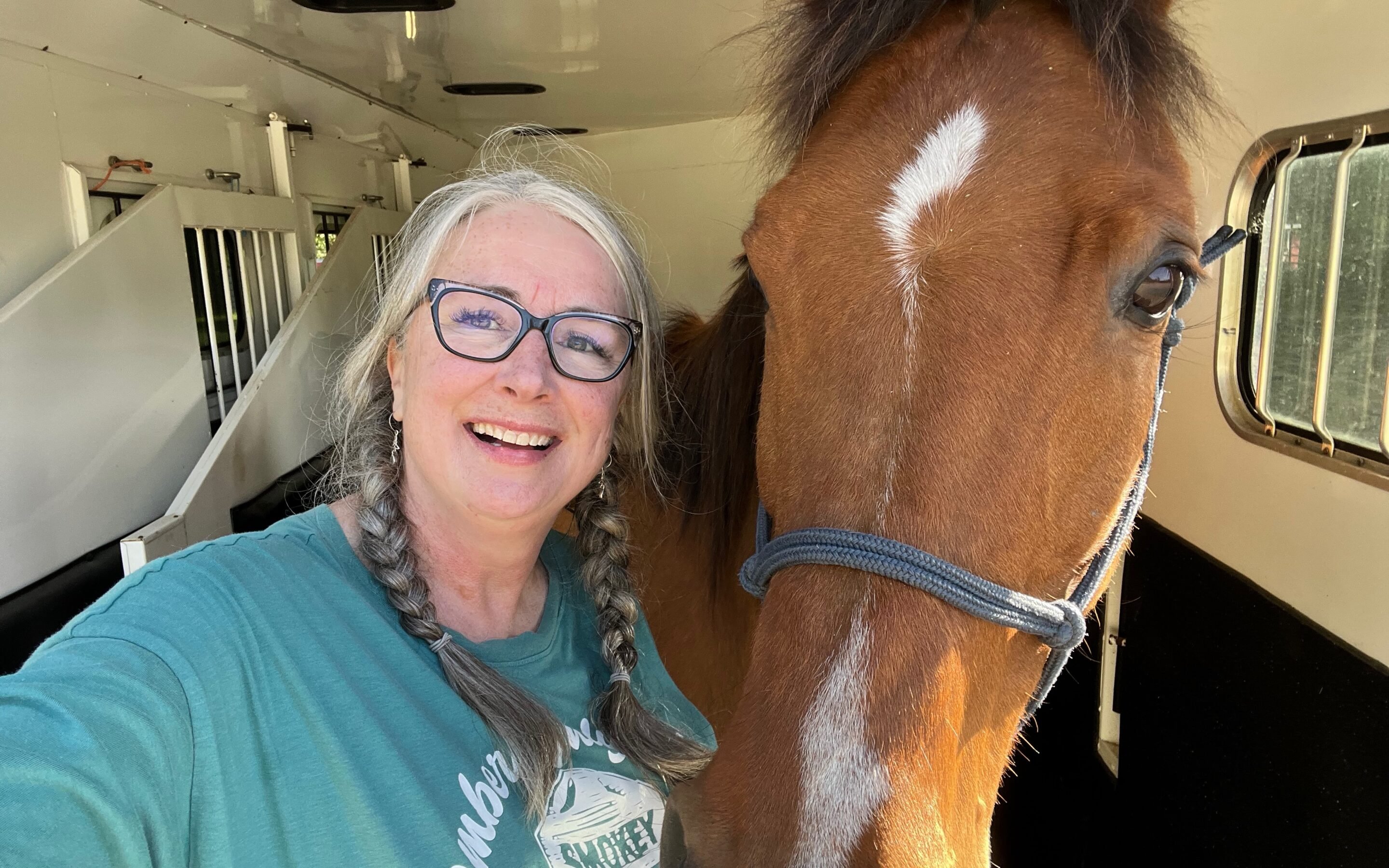
Heroic Henry
Two weeks ago, we reported that Henry had regressed in his training a bit, becoming unfocused and exhibiting herd-bound behavior. A new routine was established for him: stand tied in the big covered arena while Jax gets worked, followed by some moving and flagging along the wall, followed by ground work with an emphasis on coming down from the trot to a relaxed walk, followed by trot poles, and then concluding with a trailer loading session. Happily, with consistent daily sessions, brave and sensible Henry made a reappearance.
Standing tied, as opposed to pawing tied, or piaffing tied, or screaming your fool head off tied, was a challenge for herd-bound Henry. He’s smart enough to know not to pull back, but he showed a lot of agitation when we began. I never left him tied up by himself in the arena, but while I worked Jax, Henry was left to figure things out on his own. Eventually there were brief periods of quiet between the screaming and pawing, and then the quiet bits started getting longer. He’s still got a way to go, but he’s much improved with this particular skill.
The objective of moving a horse while its tied is to show them that they can calmly and freely move their feet if they need to. Henry grasped this concept pretty quickly, but his concern about the flag meant that he wasn’t moving in a calm or relaxed manner. But with continued work, he got better. I saw the biggest change while touching him with the flag; he didn’t like it, but he tolerated it and eventually seemed to realize that it wasn’t such a big deal after all. This had significant effect on later lessons, particularly trailer loading.
Next up was ground work. A light sensitive horse like Henry can be a pleasure to work with on the ground, but not when that horse is frantically looking past you to try to spy his buddies in the pasture. To get his focus back, I kept him moving with lots of direction changes and lots of transitions. If you’ve followed Henry’s story thus far, you’re undoubtedly aware that transitions, especially the downward ones, have not been Henry’s forte, but he made great progress. By the end of the week, he was responding to non-verbal cues to come down to the walk, which was lovely to see.
Henry is great at trot poles, and we’ve used them since his arrival in hopes of strengthening his sticky stifles. I hope it’s not wishful thinking, but I feel like he’s having fewer stifle episodes every session.
On to trailer loading! Rumor had it that Henry was impossible to get into a trailer, so much so that his previous owner had to walk him from one location to the next. Obviously that’s not completely true because he was loaded into SAFE’s trailer on the day he was rescued, but we still accepted the fact that trailer loading was going to be a challenge. Using our three horse that has a ramp, we approached trailer training one small step at a time. Along the way, there were several encouraging behaviors that Henry displayed. One was an enormous amount of try. He’d step onto the ramp, and just look SO ready to take another step, if only he could! He remained nicely focussed on me during these sessions, and paid close attention to what he was being asked to do. He did not fly backwards off the ramp every time he made forward progress, and in fact, I could approach and pet him and he would make no attempt to back out. Best of all, he wasn’t overreacting to the use of the flag, so it became a useful tool if I chose to use it. It took seven days before he got all four feet into the trailer, but once he did, from that moment on, he would walk right up the ramp and into the trailer on a loose lead, no flag or pressure from behind needed. We established that the trailer was a good place, peaceful and quiet, and Henry is on board with it. Super proud of this special horse!

Figuring Out Henry
Figuring out horses is a thing we have to do a lot here at SAFE. Rarely do they come with instructions. Their histories often begin at the point where they’re rescued, and we can usually only guess at what their lives were like before. We watch for clues or hints. We reinforce the good behaviors, and discourage the bad. When past neglect has been a factor in shaping a horse’s personality, we may have to convince a horse that he or she really truly is a good horse. With enough encouragement and support, eventually we can help improve their self-image and make life a little more comfortable for them.
This is a challenge that we’re facing with Henry. This handsome Arabian gelding experiences a lot of anxiety. When we met him, he was reluctant to be caught. Of the 15 horses we rounded up and loaded into trailers that day, Henry was last to be haltered and last to be loaded. Once home at SAFE, he was shy around his paddock cleaners, and only seemed truly enthusiastic about the arrival of Kaya with his breakfast. I started working with him regularly in the round pen, and pretty soon, he would meet me at his gate and help me put on his halter when I came to fetch him. When I exposed him to new situations, he would react with anxiety, but seemed to take some degree of comfort when I’d reassure him. Eventually he was able to participate in a Joel Conner clinic with 12 other horses in the arena, and relax enough to actually listen and learn. Things were looking up.
For the first six months at SAFE, Henry lived in a one-horse paddock between two mares, and he seemed pretty content and comfortable with that set up. In April, he was moved to a bigger paddock that he shared with Jax and Picasso, two geldings from the herd he was rescued with. Right away we noticed that Henry kept his distance from the two other boys, preferring to stand by the gate and gaze over the fences at Darla, Zelly, and other mares. And when he was taken out of his paddock for groundwork sessions, he began displaying some rather annoying herd bound behaviors. He was distracted, looking across the farm for his friends and calling for them repeatedly. Getting him to focus on his handler was a huge challenge. He still remembered his ground work, but at the slightest release, his head would shoot up, he’d focus off into the distance, and he’d holler at the top of his lungs, often right in my ear…
So it’s back to the drawing board with Henry. He’s been moved back to a one-horse paddock, though not the same one he occupied before. He gets worked 5–6 days each week. He practices standing tied, and he needs a lot more practice because he does not yet choose to stand quietly. He’s trotted over poles, worked on the ground, and he’s even learning to load into the trailer. The thing about Henry is that when he’s capable of focusing, he’s a lovely horse. He’s light, responsive, and quite easy to move and direct. So we’ll keep working with him, and hopefully his anxiety will lessen as he gains confidence in himself. This is one of the outcomes that our horsemanship methods encourage, and we’ve seen many a herd-bound horse lose its anxiety as new behaviors are developed and confidence is gained. Henry is a smart, sensitive horse, and he will be just fine.
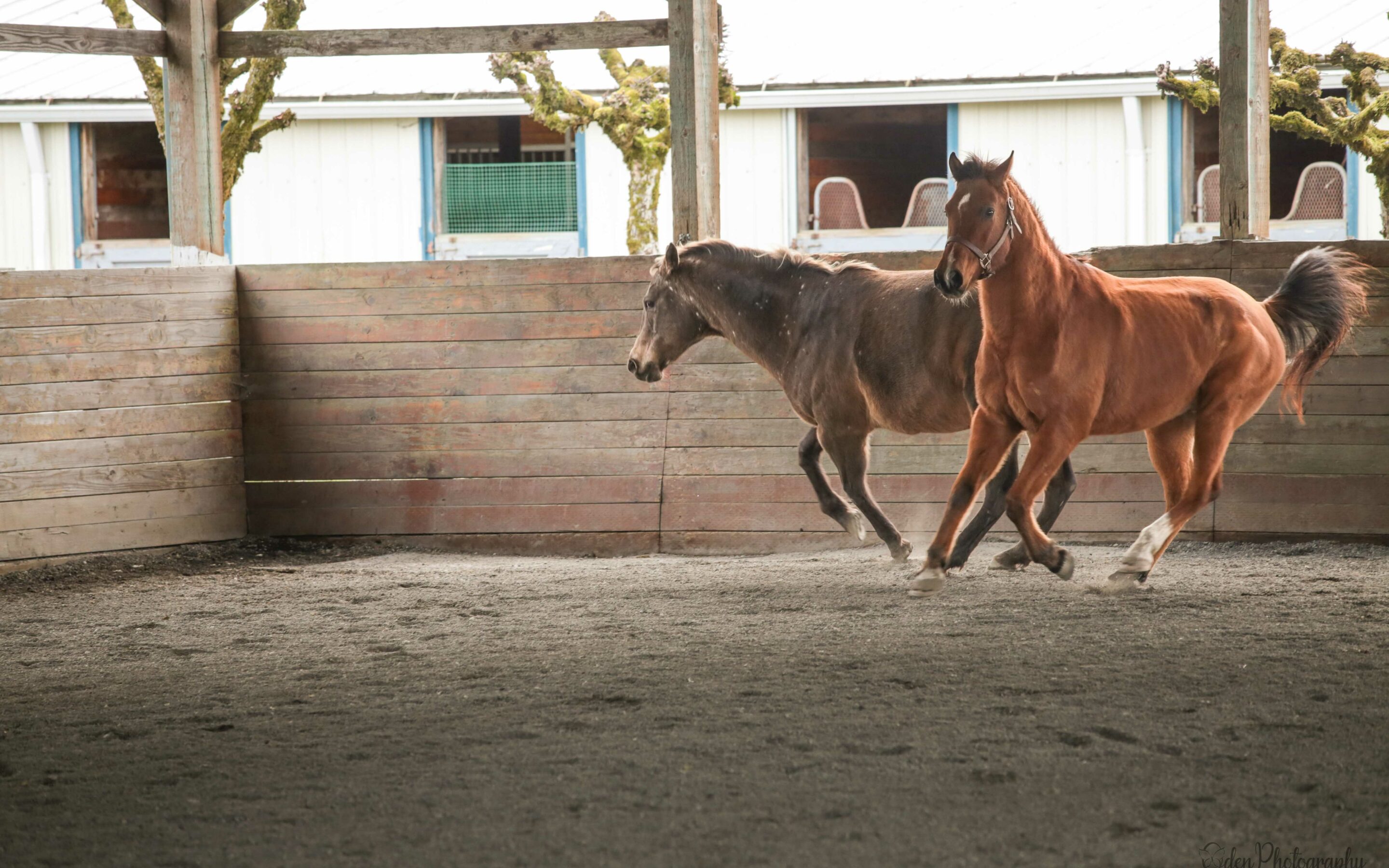
Regarding Henry
The first challenge that Henry and I faced together was helping him understand that “walk” is a gait that he’s allowed and in fact encouraged to use. Like many of the Graham horses, Henry would set off like a bat out of hell when turned loose in the round pen. He’s got a rather gorgeous floaty trot, and he looks quite flashy when he’s going around at top speed with neck arched and his tail up in the air. But he needed help to understand that what we really want to see from him is relaxation. So while I taught Henry he could relax, he taught me how to alter my feel in a more subtle manner. It doesn’t take much to make Henry move forward, and he always stays pretty focused on his handler, so before too long he learned that he could walk or trot slowly and still be regarded as a good horse.
“Henry has weak stifles that “stick” from time to time, especially when he’s moving in a smaller circle or backing up. So we added trot poles to our routine to help strengthen his hind legs. Henry is a total pro when it comes to trot poles, and his movement over poles is breathtaking. His stifles seem to be improving, but we’re still seeing them stick, especially when the weather is colder. When they stick, he usually just gives a little kick and works it out himself. But we’re not yet 100% sure if we’re going to start him as a riding horse, due to this issue.
“Introducing the flag was a bit more of a challenge, because Henry found that piece of fabric on a stick VERY alarming. He’s still a bit reactive to it, but he’s come a long way. Now we can pet him with the flag to show that it’s not so scary, and we can use it to add energy without him leaving the ground. He’s learning his groundwork very well. He’s so “light” that it’s pretty easy to guide him where we want him to go, but he still has habits like falling in at the shoulder that show themselves from time to time. A small reminder that he can’t move over top of his handler does the trick. As I said before, he’s always very focussed on his handler, which is good, but also a sign of his anxiety, which is not good. I try to reassure him that there’s nothing to worry about, and that he can handle anything I ask him to do. He’s a smart horse, and he tries very hard, all the time.
I enjoy working with Henry so much. He’s a very sweet horse with a ton of try, and even though there are things that he finds scary, he tries very hard to be brave. I can’t help but admire him. He’s a good horse!
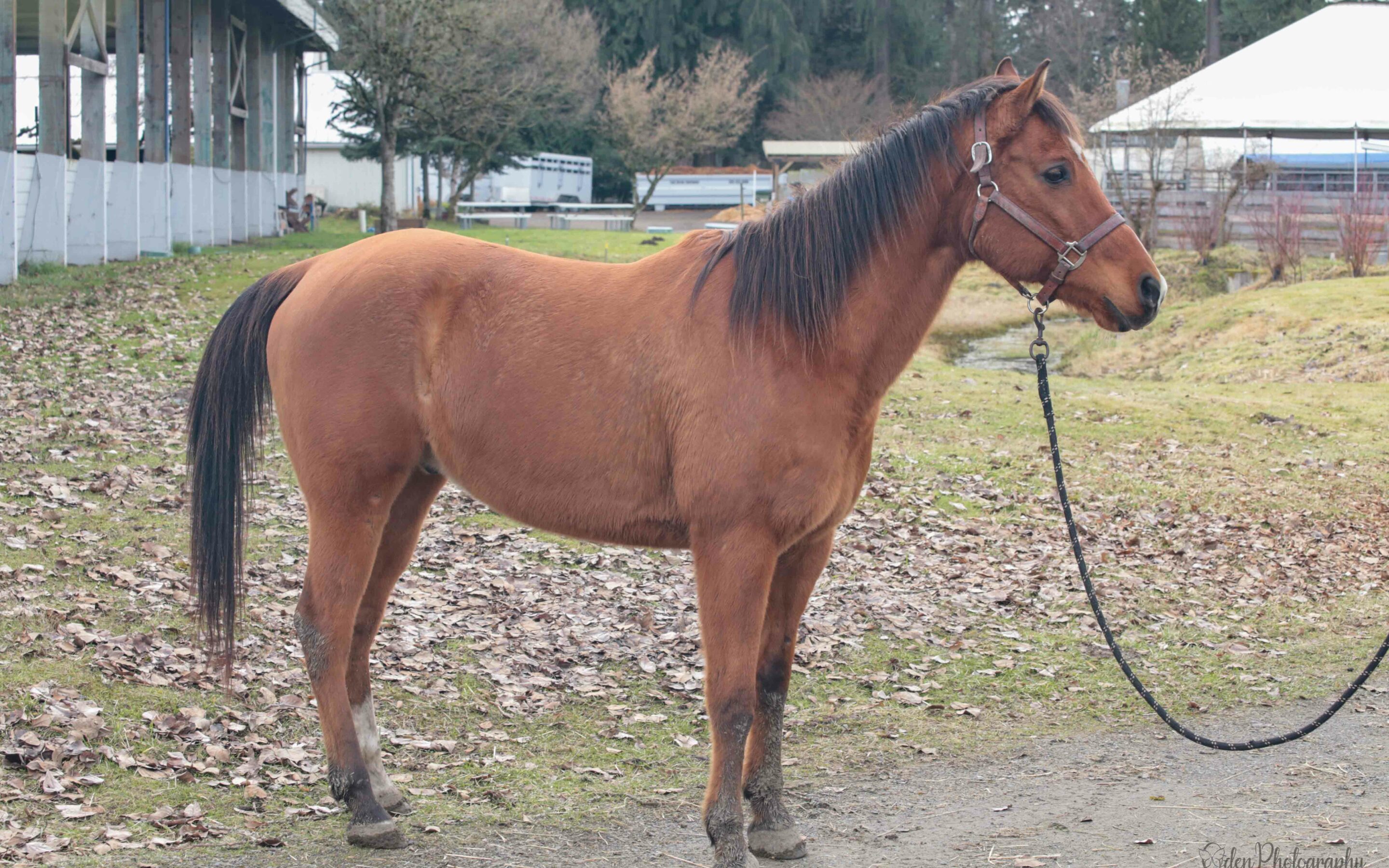
Henry Health Update
All of the Graham horses are up to date on medical care, and have already had their feet done twice. Henry is no exception to this.
The nervous, wild-eyed horse who arrived at SAFE after what was likely his first trailer ride is a far cry from the sweet horse who we are getting to know. This is not to say he is not still looky, but he has graduated from needing to live in a breakaway halter, as he is now easily caught — even in spaces like the big arena, where he goes for turnout.
Despite his anxious nature, he was a very good boy for his initial hoof trim, and was equally as well behaved for his second trim. His feet, like all the rest, are in need of some serious rehabbing. His hooves are the best out of all of the Graham horses, but that’s not to say they are good, all four hooves have significant thrush. But he is a real saint for his treatments.

At his dental, Henry had some of the most overgrown teeth of the bunch. He had substantial hooks (we like to joke about ‘fangs,’ but the reality is that such sharp teeth can and did lead to ulcerations in the mouth). All horses wear their teeth differently and at different rates, so it is difficult to determine when a horse has previously had a dental, but with a case like Henry’s, with such severe overgrowth, it is clear that his float was as overdue as his teeth were long.
Henry has really come out of his shell, and now that he is in good health we look forward to spending more time with him.

Getting to Know Henry
Henry, who arrived wide-eyed and nervous (it was his first time on a trailer, coupled with the uncertainty of a new place), has really begun to settle in at SAFE. He spends his days in a turnout with appaloosa mares Zelly and Evie on either side, and the three go to the big arena together on the daily to stretch their legs and take communal naps. Despite his initial look of uncertainty, Henry is a real sweetie who stands well for being groomed and having his feet handled. Because of his difficulty to catch, we had him in a breakaway halter his first few weeks at SAFE, but we have begun to phase the need for it out – he has made huge progress in being more trusting of us humans and therefore ‘catchable.’
Henry is up to date on vet and farrier care. He has had a dental float, his sheath cleaned, and is up to date on his vaccines. He was also dewormed upon arrival, as he arrived with a positive worm load. He has been trimmed twice since arriving at SAFE, with a 6 week trim schedule set going forward. He gets daily thrush treatments to help combat the thrush all the Graham horses arrived with.
Henry has a slight issue with locking stifles, which we had our vet evaluate. She feels that with exercise and conditioning, we will see improvement, so we will start Henry on various things to help, like sending him over trot poles and doing some hill work.
Henry is a soft and sensitive guy, and is very responsive. So many of the Graham horses are on the duller side of the spectrum, but Henry leans in the opposite direction. We have spent a little time with him in the round pen, assessing him, and running through the first few pages of the Red Book with him. He is very responsive to the flag, but still needs to learn the difference between it meaning something and it meaning nothing. We are working on trying to get him to just walk out on the rail (he is very good at trotting), and find relaxation there. Because he is so sensitive, we feel he will do extremely well in our training program, and quickly progress.

